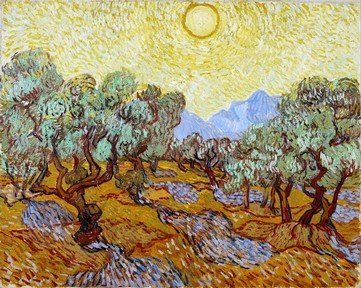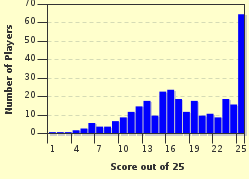Quiz Answer Key and Fun Facts
1. Hans Baldung Grien painted in 1531 a Roman hero who held his right hand in an open fire to impress the enemy. Who was this Roman hero? Mind you: some sources state that he might be a fictional character.
2. César Baldaccini (commonly known as César) produced between 1972 and 1980 a bronze sculpture rendering homage to one of the best-known Chinese communist leaders. After whom was this sculpture named?
3. Théodore Chassériau made in 1840 a drawing depicting the death of a Greek poetess. Which poetess fell (or leapt) from the Leucadian Promontory into sea?
4. Cranach the Elder completed in 1543 a diptych portraying Martin Luther and his wife. What is the name of Martin Luther's wife?
5. Honoré Daumier published in 1862 a lithograph about a pioneer of photography. Who was this early photographer, who (according to Daumier) elevated "Photography to Art"? In 1858, this photographer made the first aerial photos.
6. The "Consecration of Napoleon" was of course a very fruitful subject for historic painters. Which of the following French artists is the best known painter of this scene? His painting was completed in 1807, three years after the famous event.
7. David d'Angers made in 1811 a bas-relief showing us the death of a successful Theban general. This general lived from 410 BC until 362 BC. A few years after Epaminondas helped Thebes to gain independence from Sparta, Thebes succumbed to a new enemy: Philip of Macedon. Who was the Theban general depicted by David d'Angers?
8. "Liberty Leading the People" is one of the most controversial historic paintings ever made. Who created this iconic image in 1830?
9. Albrecht Duerer was a prolific painter and graphic artist. He is also one of the very few artists whose portrait of a banker can be found in a museum, rather than in a private collection. Who was the banker portrayed by Duerer in 1518?
10. The "Statue of Liberty" (1886) was a gift from the Republic of France to the United States of America. The sculpture was made by Frederic Auguste Bartholdi, on a framework made by the company founded by another famous French architect. Who was the founder of the architectural company responsible for the framework of the Statue of Liberty?
11. Filarete (Antonio Averlino) left us in 1465 a bronze miniature of the "Equestrian Statue" of a Roman Emperor. The original can still be admired in Rome, while Filarete's miniature is on sight in a museum in Dresden (Germany). Which Roman Emperor inspired Filarete? This Emperor is nowadays considered as one of the five "Good Emperors".
12. Fra Bartolomeo made in 1498 an impressive portrait of a Dominican friar who was executed in the same year. Who was portrayed by Fra Bartolomeo? This portrait can be found in a museum in Florence, Italy.
13. Who made a series of paintings portraying King Henry VIII as well as at least three of his six wives? These paintings date from 1536, 1537, 1539 and 1541.
14. In 1973, Arata Isozaki named a chair after a movie star from the Fifties. Who was this movie star?
15. The "Battle of the Kearsarge and Alabama" was one of the few naval engagements in the American Civil War that attracted European attention. Which French Impressionist dedicated in 1864 a painting to this naval battle?
16. The "Portinari Triptych" is one of the masterpieces of a "Flemish Primitive" painter. Which painter depicted a Madonna with child surrounded by the donors Tommaso Portinari and his wife?
17. Mies van der Rohe built in 1972 a Memorial Library in Washington DC named after one of the Nobel Prize winners of 1964. After whom was this library named?
18. "A Huguenot on St. Bartholomew's Day" was the subject of a painting by one of the founders of the Pre-Raphaelite Movement. Who completed this painting in 1850?
19. The "Abolition of Serfdom in Russia" inspired a Czech painter. Who left us this painting in 1920?
20. Raphael decorated the Stanza della Signatura in the Vatican with a philosophical theme. What is the title of this artwork completed in 1509?
21. Salvator Rosa painted a Greek philosopher explaining something to a bunch of fishermen. I never thought fishermen would be interested in a theorem on right triangles. Who was this famous philosopher?
22. A French painter made a portrait of cabaret singer Aristide Bruant for his performance at the "Ambassadeurs" in 1892. Which French painter, fascinated by Parisian night-life, made this poster?
23. The "Portrait of Dr. Gachet" was auctioned in 1990 for the sum of 75 million dollars (plus expenses), making this painting by far the most expensive portrait of a doctor ever made. At the time of the auction, the painting was exactly 100 years old. Which Dutch painter made this portrait which became only extremely valued after the artist's death (as was the case with almost all of his works)?
24. The "Battle of Lepanto" was a sound victory of the Venetian navy (combined with other navies) over the Turks in 1571. No wonder a Venetian artist chose this naval battle for a painting he made in 1572. Who commemorated this naval battle in this way?
25. "The First of May, 1851" is one of the masterpieces of a minor German painter. Who depicted the events of this day in history? The painting was made in the very same year its title mentions.
Source: Author
JanIQ
This quiz was reviewed by FunTrivia editor
CellarDoor before going online.
Any errors found in FunTrivia content are routinely corrected through our feedback system.

